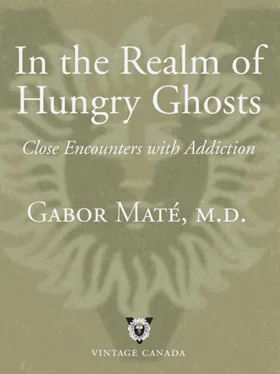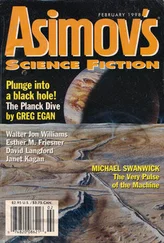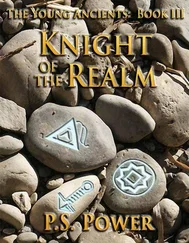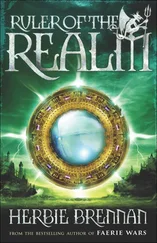A regular finding of brain-imaging studies on drug addicts is underactivity of the OFC after detoxification. 9In a similar vein, psychological testing of cocaine addicts has shown impaired decision making. In one study, some key aspects of their decision-making ability was a mere 50 per cent of normal. Only people with physical injury to the frontal cortex would score lower. 10
It may seem paradoxical, but the OFC is also highly activated during craving—not to enhance decision making but to initiate craving itself. It turns out that different parts of the OFC have different functions: one part is involved in decision making; another in the automatic and emotional aspects of craving. 11In imaging studies the OFC lights up when an addict so much as thinks about her drug. 12
An abnormally functioning OFC has also been implicated in compulsive behaviours in both human and animal studies. A rat with a damaged orbitofrontal cortex will persevere in reward-seeking, addiction-type activities even after the rewards are removed. As the researchers comment, “these findings are reminiscent of the reports of drug addicts who claim that once they start taking a drug of abuse they cannot stop even when the drug is no longer pleasurable.” 13

If we consider the likelihood that Claire’s apparatus for rational judgment and impulse control—including, prominently, the OFC—is impaired, we can begin to understand her aggressive behaviour the day before and also appreciate her argument that she does not “deliberately” use cocaine. With a malfunctioning OFC, she has little impulse inhibition. Instead, she carries immense, chaotic, ever-seething rage in her body and brain. Claire was raped repeatedly by her father over many years while her mother either didn’t notice or looked away. Based on her history, it’s certain that Claire also suffered psychological and physical abandonment almost from the moment of her birth. The emotional traces of those events are encoded in nerve patterns in her OFC, and that includes experiences she cannot consciously recall. *16
Cocaine disinhibits aggression. With little impulse control to begin with, under the influence of the drug Claire can become a rage machine—automatic, autonomic and, at such moments, virtually without conscious will.
But what about the “choice” I said she had when I was talking with her in my office—the choice to use cocaine the day before in the first place? Let’s consider that question from the perspective of brain activity. It is not hyperbole to say that drugs have been the chief source of consolation that Claire, now in her thirties, has ever found. Ever since she began using in adolescence, they’ve offered her relief from searing emotional pain, loneliness, anxiety and a deep-seated fear of the world. As a result, her OFC has been trained to create a powerful emotional pull toward the drug from the second she even thinks about “fixing.” Addiction research refers to this dynamic as salience attribution: the assignment of great value to a false need and the depreciation of true ones. It occurs unconsciously and automatically.
We can now reconstruct yesterday’s events. When Claire sees the plastic bag with the white cocaine powder, the needle and the syringe—or when she so much as thinks about them—her brain will respond in a highly positive way. Owing to the OFC’s influence on the incentive centres described in the last chapter, dopamine will start flowing in Claire’s midbrain circuits. This causes the craving for the drug to intensify. Any thoughts of negative consequences are thrust aside: the part of the OFC that might speak up to warn her of these consequences is “gagged and bound.” Thus Claire’s OFC, impaired by years of drug use and perhaps even before then, encourages the self-harming activity, rather than inhibiting it. She injects.
Ten minutes later she takes her seat outside my office. Someone says the wrong thing—or she believes they do. Her OFC, unconsciously primed to recall the many times she has been attacked, insulted and injured, interprets this stimulus as a serious aggression. Claire is triggered. According to PET scans, the OFC distinguishes and reacts to angry, disgusted and fearful facial expressions in other people but not to neutral facial expressions. 14Literally, all the “offending” person had to do was to look at Claire the wrong way.
After reading this description, you may think that I believe drug addicts bear no responsibility for their actions and have no choices. That is not my view, as I will explain later. I hope it’s clear, however, that in the real world, choice, will and responsibility are not absolute and unambiguous concepts. People choose, decide and act in a context—and to a large degree, that context is determined by how their brains function. The brain itself also develops in the real world, influenced by conditions over which the individual, as a young child, had no choice whatsoever.

In this chapter we have seen that the orbitofrontal cortex, a central part of the brain system that regulates how we process our emotions and how we react to them, participates in substance dependence in a number of ways. First, it emotionally overvalues the drug, making it the chief concern of the addict—and often the only concern. It undervalues other objectives, such as food or health or relationships. By becoming triggered even at the thought of the drug (or activity) of choice, it contributes to craving. And finally, it fails at its task of impulse inhibition. It aids and abets the enemy.
All of this would explain an astonishing conversation with another patient, Don. It began with something he casually said as he sat down to wait for his methadone prescription.
“You what?”
Don sees my incredulity and gives me the sly smirk of a kid confessing a misdemeanour to an indulgent uncle. “You heard me. I pissed on the guy’s leg, outside the pharmacy. The prick kept bothering me, so I said, ‘George, you’re talking a lot of bullshit. Is it wet enough for you?’ And I took a leak on his pants.”
I’m still shaking my head in disbelief. “You did that?”
“Yeah. I pissed on George’s leg.”
Don is in his thirties and, besides his methadone, he’s on tranquilizing medications to control his behaviour. They do work well until he uses crystal meth. Then nothing works.
“All right, you did,” I say. “Do you think that’s appropriate?”
Today Don is clear of the drug, and he ponders my question for a moment before responding.
“No, it was pretty stupid…but…sometimes it’s like…It’s like, with my addiction…it’s like I’m a child not released.”
That’s it—the neurobiology of addiction in a nutshell. Attacking energy, expressed as tantrums or aggression, rapidly erupts from a young child because the brain circuits that would allow him to resolve his frustrations in other ways are as yet unformed. The impulse control circuitry isn’t connected yet either. Don, who has been a user since his adolescence, was never very mature to begin with. Decades of life as a drug addict have permitted very little continued maturation of either his behaviour or his brain. His experience tallies up with studies showing that the volume of drug users’ grey and white matter is diminished and that this loss of cortical mass is correlated with length of drug use. 15
Don has spent years living without any place to call home, surviving in the urban jungle by dint of street smarts, quick reflexes and intuition. Anywhere else he is out of his element. He’s developed a cunning wisdom of sorts but never the capacity for self-control or normal social interaction or anything close to emotional balance. When his underdeveloped brain mechanisms are overwhelmed by drugs, he becomes—exactly as he says—a very young human being, not yet released from childhood.
Читать дальше













